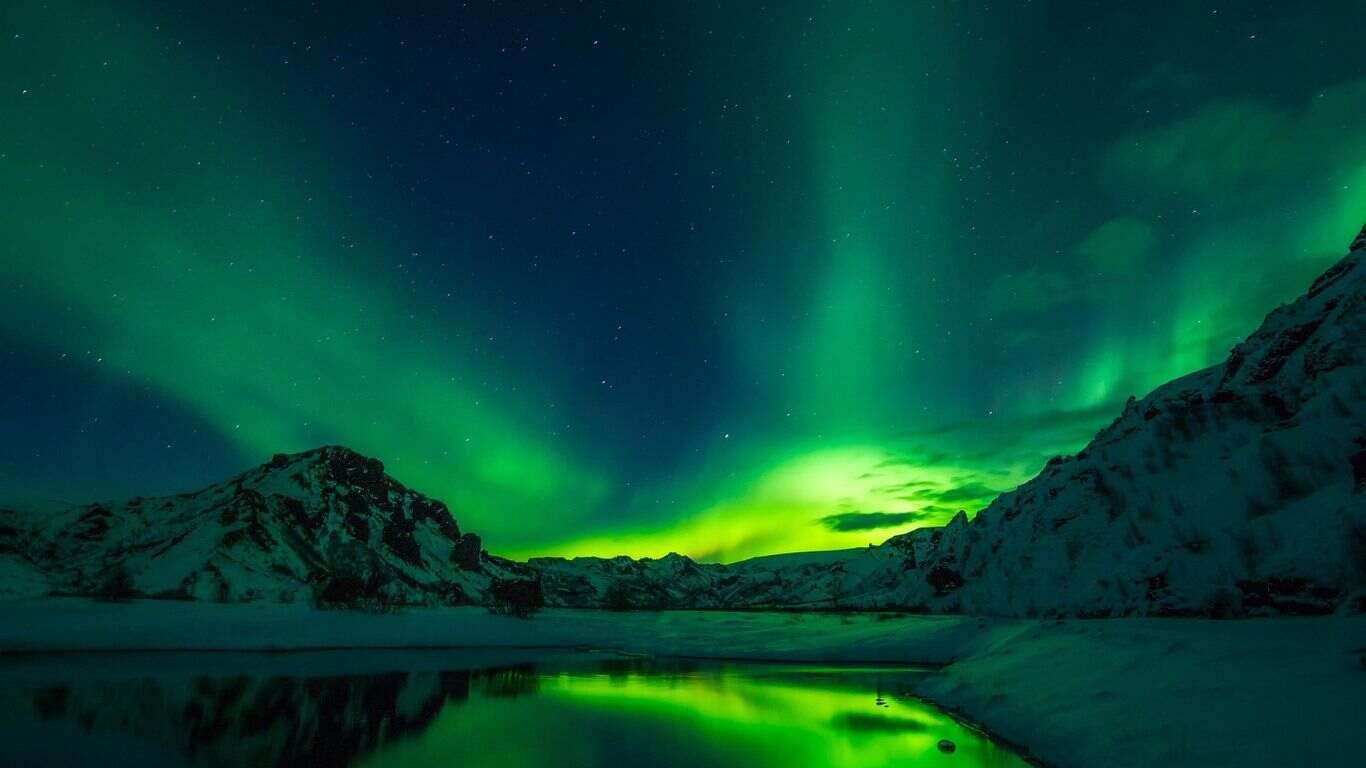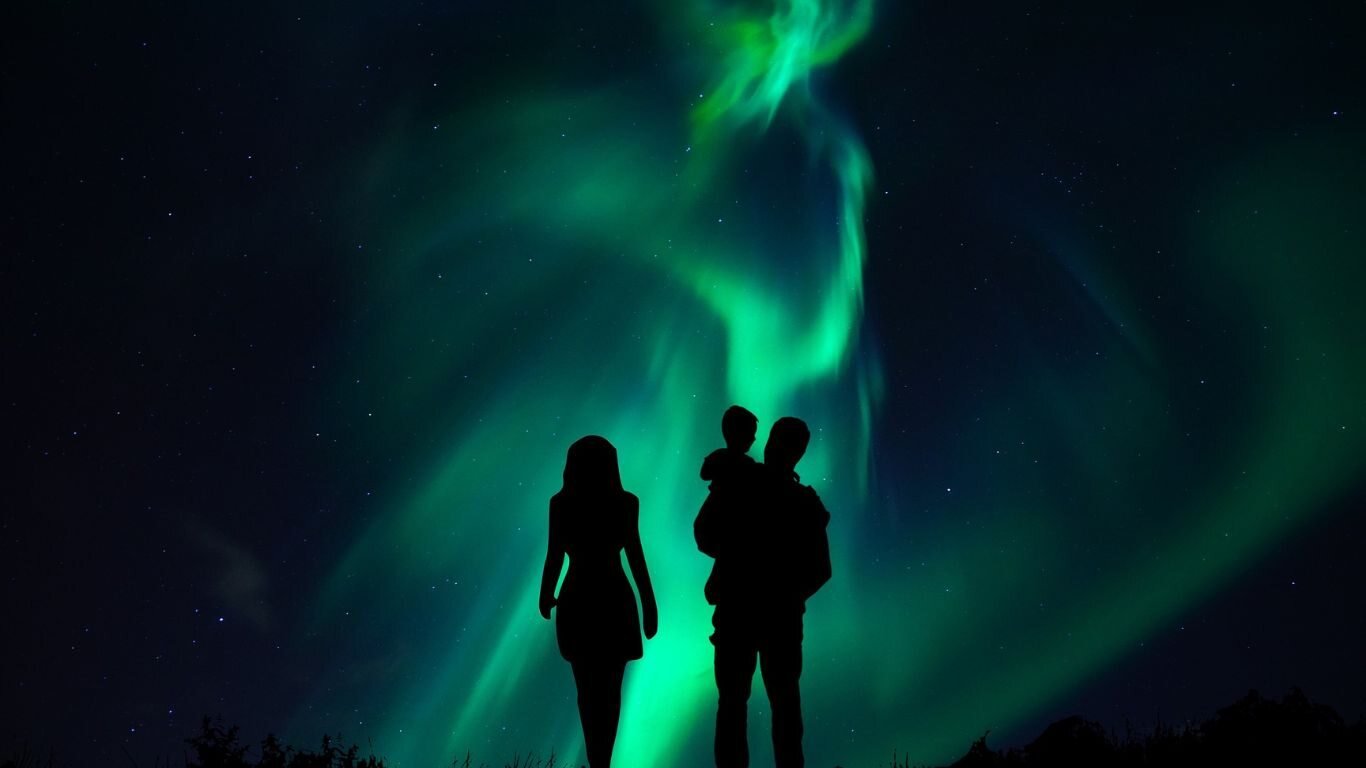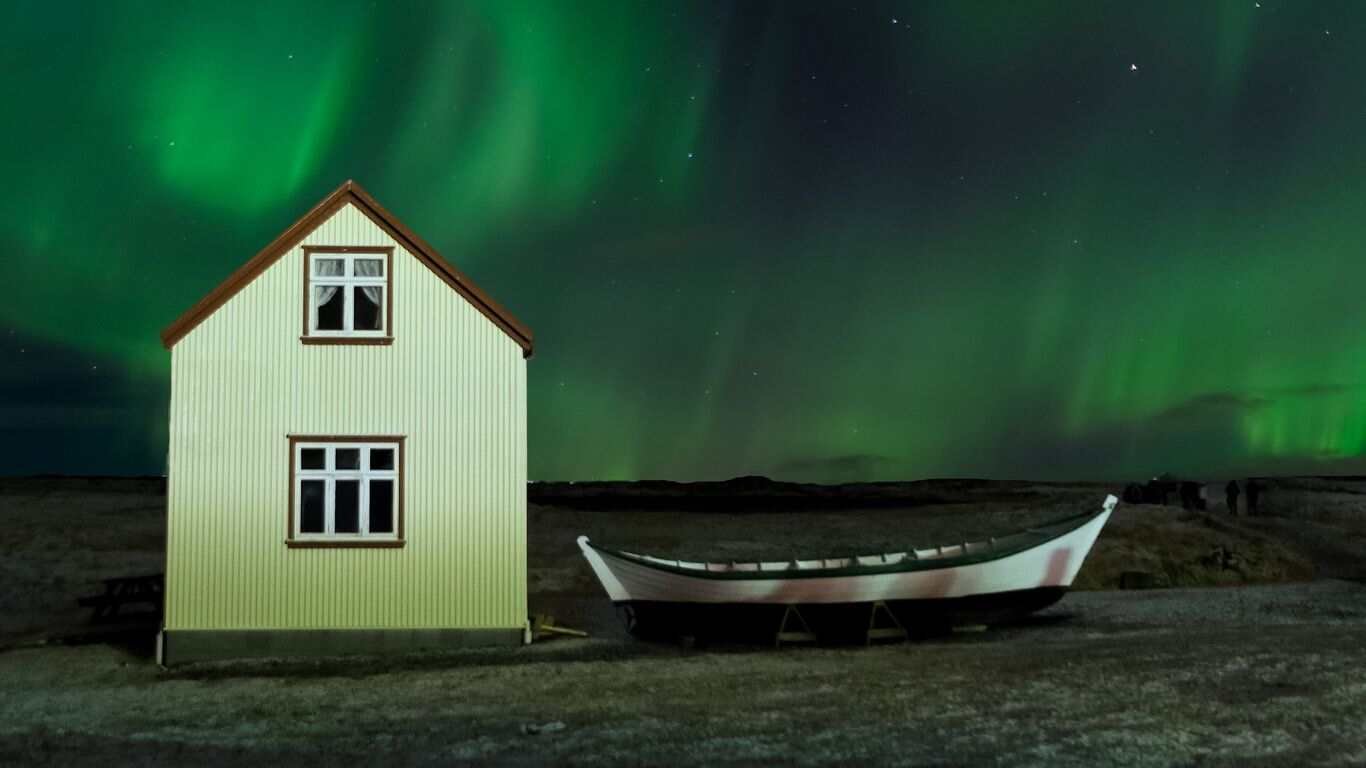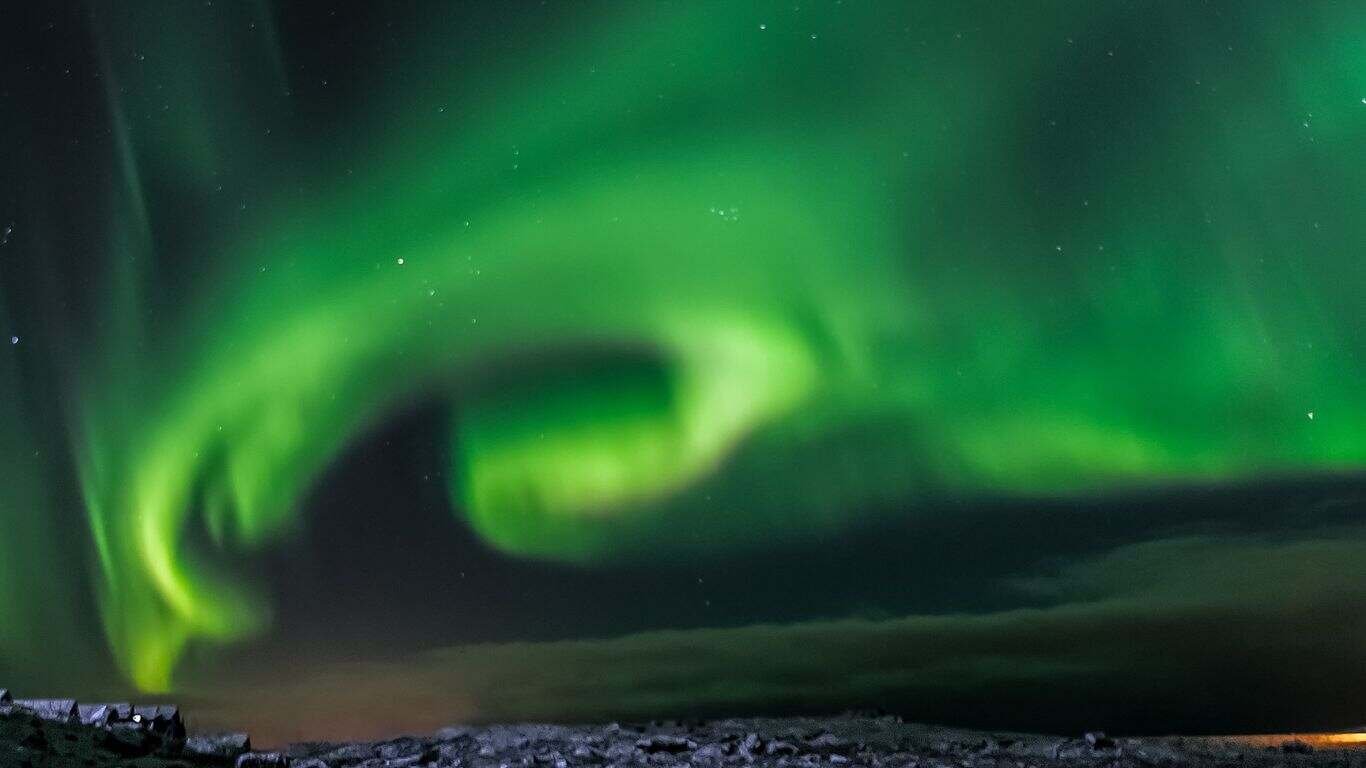
Table of Contents
ToggleIntroduction
One of the most beautiful natural phenomena is the Aurora Borealis, also known as the Northern Lights. Travelers from all over the world are drawn to the Arctic by these vibrant lights that dance across the sky. Seeing the Northern Lights is one of the most exciting things that tourists look forward to when they plan a vacation to Iceland.
People have been enthralled by the Aurora Borealis, or natural light show, for ages. Not only are the erratic hues that adorn the Arctic skies stunning, but they also have a mystical, even unearthly quality. Finding out when is the best time to see Northern Lights in Iceland is crucial if you want to see these phenomena in all its splendor. This all-inclusive guide will provide you all the information you need to make sure your trip to witness this magnificent show is one you won’t soon forget.
Understanding Behind the Scene
Why Do the Northern Lights Occur?
A complicated interaction between solar winds and the Earth’s magnetic field produces the magnificent Northern Lights. The lights specifically happen when charged solar particles penetrate Earth’s atmosphere and come into contact with gases such as nitrogen and oxygen. The light that is released as a result of these collisions is what we see as the Aurora Borealis. Iceland is among the greatest spots in the world to see this phenomenon, which mostly happens close to the magnetic poles. Given that the best time to see Northern Lights in Iceland is intimately related to solar activity, it is imperative to comprehend these variables.
Depending on the kind of gas involved in the collisions, the Northern Lights have different colors. The most prevalent hue, caused by oxygen molecules at lower altitudes, is green. Oxygen also causes red, which is less common, but at considerably higher elevations. Meanwhile, purple and blue colors are produced by nitrogen. The show is a marvel that can be explained scientifically rather than being merely a chance event. The best time to see Northern Lights in Iceland is made much more amazing when one understands the science behind it.
The Significance of Solar Activity
There is a clear correlation between solar activity and the Northern Lights’ visibility and intensity. The solar activity cycle lasts eleven years, during which the sun experiences high and low activity. Solar maximums, when solar activity is at its highest, are when the Northern Lights are most common and vivid. On the other hand, there are fewer and fainter lights during solar minimums. Often, these solar peaks coincide with the best time to see Northern Lights in Iceland. Sudden surges of energy from the sun, known as solar storms, can produce particularly striking displays. You can choose the best evenings to go out by monitoring sun activity with a variety of applications and websites.
Local Culture and Northern Lights Mythology
Icelandic Folklore
Not only are the Northern Lights a sight to behold, but they also have a rich history in Icelandic legend. The lights have been the focus of several stories and legends for centuries. The lights were once thought to represent either dancing ghosts in the sky or perhaps the Valkyries making their way to the afterlife. Some tales about Iceland state that the lights served as a bridge connecting the divine and the mortal realm. Knowing these tales gives your encounter a deeper cultural meaning, turning the best time to see Northern Lights in Iceland into a cultural adventure as well as a visual marvel.
Celebrations and festivals
In Iceland, there are often festivals and other local celebrations taking place during the Northern Lights season. For example, Reykjavik’s Winter Lights Festival, which takes place every year in February, honors both the wintertime and the Northern Lights. The festival offers guided excursions that highlight the Aurora Borealis, light installations, and cultural activities. Participating in such events during the best time to see Northern Lights in Iceland might enhance your trip by providing a unique opportunity to combine scenic beauty with cultural immersion. These celebrations also offer a chance to discover more about Icelandic customs and tales pertaining to the lights.

Location
Best Places in Iceland to See
It’s critical to be in the appropriate location at the right time in order to increase your chances of witnessing the Northern Lights. Iceland has a lot of great spots with less light pollution, which is important for the best viewing. The greatest places to visit include the Snaefellsnes Peninsula, which provides a range of picturesque settings; Jökulsárlón Glacier Lagoon, where lights may be seen reflecting off icebergs; and Þingvellir National Park, which is renowned for its stunning scenery and historical significance. Choosing these sites will substantially improve the best time to see Northern Lights in Iceland because the dark skies provide the Aurora Borealis an ideal canvas.
Still less crowded viewing options can be found in areas like the Westfjords and Akureyri in North Iceland. A more personal encounter with the Northern Lights can be had in these more secluded sites. Since the evenings are longest and the skies are darkest throughout the winter, this is usually the best time to see Northern Lights in Iceland in these areas.
Off-the-Beaten-Path Locations
There are several lesser-known locations in Iceland that provide fantastic Northern Lights viewing without the crowds, for those looking for a more private experience. Locations such as the Highlands, which are only accessible during specific times of the year, and Borgarfjörður, an area well-known for its geothermal activity, offer a distinctive backdrop for seeing the lights. In addition to making the best time to see Northern Lights in Iceland even better, these off-the-beaten-path spots provide a deeper opportunity to interact with nature. Watching the lights dance across the sky is made more intimate and contemplative by the peace and seclusion of these locations.
Weather
The Perfect Weather Situation
What constitutes the best time to see Northern Lights in Iceland depends in large part on the weather. It is necessary to have clear sky because even a little cloud cover can make the lights invisible. The weather in Iceland is very unpredictable and changes quickly. When it comes to seeing the Northern Lights, the winter months are ideal, especially from late September to early April. The lengthy nights during this season allow you additional opportunities to see the lights. But since weather patterns may change quickly, it’s critical to be adaptable with your plans and seize clear skies whenever possible.
Cloudless, chilly, and crisp nights are the best conditions for seeing the Northern Lights. The sky is usually cleaner in the winter because the chilly air tends to hold less moisture. These excellent weather conditions are commonly associated with the best time to see Northern Lights in Iceland, especially in October, November, February, and March when the skies are usually the clearest. To increase your chances of a successful sighting, keep an eye on weather forecasts and projections for Aurora.
Managing the Unpredictable Weather in Iceland
Although Iceland’s weather is unpredictable, there are strategies to lessen the difficulties it poses. Your chances of success rise if you plan ahead of time and spend several nights seeking for the Northern Lights. Too many tourists schedule their Northern Lights viewing for only one night, only to be let down by overcast skies. You can raise your chances of witnessing the best time to see Northern Lights in Iceland by planning for multiple evenings during your vacation. In order to make sure you don’t miss this natural beauty, guided tours frequently have the ability to transport you to alternative areas with brighter sky.
Choosing a place with a high probability of clear skies is another tactic to deal with Iceland’s erratic weather. During the winter, the weather is frequently more consistent in Iceland’s northeast and east. The best time to see Northern Lights in Iceland becomes even more worthwhile if you select a spot with a reputation for having brighter skies.
Finding the Best Spots
Some Advice for Seeing the Northern Lights
The best time to see Northern Lights in Iceland should be fully utilized by being aware of the locations and techniques for spotting them. Avoid places with a lot of light pollution first. This entails avoiding metropolitan areas and other places with lots of light. Go to rural areas or places with designated dark skies instead, where the lights will be more brilliant. Secondly, exercise patience. It’s crucial to allow enough time because the Northern Lights can emerge and disappear quickly. It is more likely that you will see the lights if you spend a few hours outside, especially between 10 PM and 2 AM, when viewing is at its best.
Comprehending the phases of the moon is also essential. A full moon’s brightness can mask the colors in the Northern Lights, making them less visible. On the other hand, a new moon produces the darkest skies, which makes the lights appear brighter. You may make the most of your time during the best time to see Northern Lights in Iceland by scheduling your travel around the new moon. Lastly, remember to pack a decent camera with manual settings. A tripod is also advised because capturing the Northern Lights needs long exposure periods and a steady hand.
Taking Advantage of Technology
Finding the best time to see Northern Lights in Iceland can be aided by technology in the modern digital era. You can identify the optimum viewing nights by using real-time data on solar activity, weather, and cloud cover, which is available on a number of apps and websites. You can have an advantage in your search for the Northern Lights by using well-known apps like My Aurora Forecast, Aurora Alerts, and SpaceWeatherLive, which provide the most recent information on Aurora forecasts. You may improve your chances of success and make sure you’re at the right place at the right time by making use of these tools.
Using live webcams put in strategic areas to witness the Northern Lights is another technological tool. With the help of these webcams, you can keep an eye on the sky conditions in real time while relaxing in your lodging. You can rush outside to observe them for yourself if the lights are visible. Because it enables you to modify your plans in response to actual conditions, this method is especially helpful while navigating Iceland’s erratic weather. The best time to see Northern Lights in Iceland is considerably easier to anticipate and take pleasure in when equipped with the proper equipment.

Timing Is Key
Seasonal Overview
Winter is the best time to see Northern Lights in Iceland, since the evenings are the longest and darkest. The best time to see the Northern Lights is usually from October to March, though they can be seen as early as late August and as late as mid-April. November through February are thought to be the greatest months during this time because of the long, dark nights and often clear sky. But every month has special benefits of its own. For instance, milder weather is available in September and October, although more steady weather is typically found in February and March during the holiday season.
The best time to see Northern Lights in Iceland is winter, but it’s also the coldest and most difficult season to travel. There are few hours of daylight in each day, and the weather can be severe. But the benefits of seeing the Northern Lights exceed all difficulties by a wide margin. The best time to see Northern Lights in Iceland can also be even more remarkable if you travel to the country during off-peak times, like late September or early April, when there may be fewer tourists and a quieter experience overall.
Optimal Hours for Viewing
Even though winter is most frequently linked with the Northern Lights, the precise time of night that they are visible is just as significant. Generally speaking, between 10 PM and 2 AM is the best time to see Northern Lights in Iceland. The greatest times to watch are during these hours when the skies are at their darkest. Though they frequently occur earlier or later in the night, the Northern Lights can be erratic. It’s best to spend a few hours outside watching the skies in order to increase your chances.
A lot of tourists want to stay in places that provide wake-up calls to the Northern Lights. These services make sure you don’t miss anything—even if you’re asleep—by alerting visitors when the lights are on. This is especially helpful if you’re visiting a distant area, where the best time to see Northern Lights in Iceland varies according to the local climate. You can improve your chances of seeing this amazing natural phenomenon by being ready to stay up late and being alert.
Travel Tips
What to Bring on Your Travel Packing List?
It is imperative to be well-equipped for the frequently severe and chilly weather in order to truly appreciate the best time to see Northern Lights in Iceland. Your level of comfort and enjoyment can be greatly enhanced by packing the appropriate equipment. Firstly, create warm, waterproof outer layers, then thermal foundation layers. Essential items for winter dressing include a cap, thermal socks, insulated gloves, and a high-quality coat. For negotiating ice terrain, boots that are strong, waterproof, and have adequate grip are also necessary. If you want to spend a lot of time outside, packing hand and foot warmers will also keep you comfortable.
If you want to take pictures of the Northern Lights, pack not just warm clothes, but also a good camera with manual settings. A wide-angle lens can aid in capturing the vast sky, and a tripod is necessary for steadiness during extended exposures. Remember to bring extra batteries because the cold can quickly deplete them. Pack a thermos with a hot beverage, some snacks, and a blanket for extra warmth to make the most of the best time to see Northern Lights in Iceland. Being ready for the cold guarantees that you won’t be sidetracked by discomfort and can appreciate the experience to the fullest.
Organizing Your Route
Planning your schedule for the best time to see Northern Lights in Iceland requires a lot of flexibility. Even with the best preparation, the Northern Lights are a natural occurrence, thus their appearance cannot be assured. Set aside numerous evenings for Northern Lights searching to maximize your chances of seeing them. Because of the wide variations in weather and cloud cover around the nation, think about booking accommodations in several regions.
During the day, there’s much to do if you’re not chasing the lights. You may find plenty of things to do throughout the day in Iceland to pass the time till dusk. Hike on a glacier, see the Blue Lagoon, and explore the Golden Circle. Northern Lights hunting may be very tiring, especially during the late hours of the night and in the winter, so it’s crucial to balance your schedule with adequate relaxation.
The Best Tours and Guides to Choose
A guided trip can be a good option if you’d rather not look for the Northern Lights alone. Northern Lights tours are the focus of many Icelandic businesses, and they provide the experience and local knowledge that may really make a difference. These trips frequently involve transportation to prime viewing locations determined by the most recent weather and Aurora predictions. To help you get the best pictures of the Northern Lights, several excursions also provide photography support.
Making the most of your stay in Iceland is possible by combining guided tours with other pursuits like trekking on glaciers or exploring ice caves. A guided tour can ease your mind and improve your entire trip, whether you’re traveling alone or with family.

Safety First
How to Keep Safe in Iceland's Winter Environment
It’s important to be ready for inclement weather because the best time to see Northern Lights in Iceland is during the coldest months of the year. If you intend to drive, make sure your car has winter tires, and for extra security, think about hiring a 4×4. Always check the weather and road conditions before leaving. Real-time updates, including information on road closures and dangerous circumstances, can be found on the website of the Icelandic Road and Coastal Administration.
It’s crucial to communicate your goals and anticipated return time to someone when traveling through isolated places. Rural places often have patchy cell phone coverage, so it’s a good idea to bring a map and become acquainted with the area. A first aid kit, additional food and water, a flashlight, warm blankets, and an emergency kit are other necessities. You can enjoy the best time to see Northern Lights in Iceland safely and without needless risk by following these guidelines.
Winter Road Driving Advice
Winter driving in Iceland can be difficult because of slippery roads, snowstorms, and high winds. Reduce your speed and keep a wider following distance than normal to be safe. When driving on less-traveled or curved roads, exercise caution since they may be more slick. In the event of a whiteout, carefully stop and bide your time until conditions improve. Additionally, because there is less daylight throughout the winter, it is crucial that you always have your headlights on.
If you’ve never driven in the winter before, you might want to consider taking a winter driving course before your trip. You may learn how to drive safely on ice and snow by taking these courses. As an alternative, think about taking a guided tour rather than driving alone if you’re not comfortable with your driving abilities. Local tour guides can make sure you get to the greatest Northern Lights locations safely because they are accustomed to negotiating Iceland’s snowy roads.
Honoring Local Laws and the Environment
Respecting Iceland’s pristine environment and local laws is essential when searching for the Northern Lights. Remain on approved viewing locations only; do not enter private property. It is imperative that visitors treat nature with the same reverence as Icelanders do. Take out all of your rubbish and leave no trace; and avoid disturbing local wildlife.
You should also know that the Northern Lights have cultural significance for Icelanders. A part of Icelandic tradition and folklore, the Aurora Borealis is more than just a scientific occurrence. You may aid in safeguarding Iceland’s scenic landscape and rich cultural legacy for upcoming generations by honoring regional traditions and the ecosystem.
How to Go There
Traveling to Iceland: Aircraft and Arrival
Getting to Iceland is easier than ever, with direct flights available from many major cities around the world. Reykjavik’s principal international airport, Keflavík International Airport, is roughly 45 minutes away. Direct flights are available from North America, Europe, and other locations with airlines including WOW Air and Icelandair. When planning your travel schedule, try to arrive between late September and mid-April, which is considered the best time to see Northern Lights in Iceland.
When you arrive, you’ll discover that the airport has all the conveniences you require. There are shuttle services, car rentals, and currency exchange available. Winter tires are a must for safe driving during the Northern Lights season, so if you’re renting a car, make sure you reserve one.
Traveling in Iceland in the Northern Lights Season
Depending on your tastes and financial constraints, you have a number of options for transportation once you’re in Iceland. You may travel the nation at your own speed and with the greatest flexibility when you rent a car. Winter driving can be difficult, though, particularly for people who are not used to snowy roads. Consider taking a guided tour or using public transit if you don’t feel comfortable driving.
Another way to go to the country’s more isolated regions is through domestic planes. For instance, there are year-round flights from Reykjavik to Akureyri in North Iceland, which allows you to reach some of the greatest locations for seeing the Northern Lights. Reykjavik is easily accessible without a car because of the buses that run throughout Iceland, connecting it with popular towns and tourist attractions.
Top Locations to See the Northern Lights
The best time to see Northern Lights in Iceland is when you should book your accommodations; think about places with clear skies and little light pollution. The Westfjords, the Snaefellsnes Peninsula, and the region surrounding Lake Múvatn in North Iceland are popular destinations. These areas, which are isolated from Reykjavik’s lights, provide some of the greatest views of the Northern Lights.
These places provide a variety of lodging options, from little guesthouses to opulent hotels—many of which have wake-up calls overlooking the Northern Lights. This service guarantees that even in the event that the lights arrive in the middle of the night, you won’t miss a sighting. You may make the most of the best time to see Northern Lights in Iceland by staying in these prime locations and properly organizing your transportation.

The Nearest Attractions
Discovering the Natural Wonders of Iceland
Apart from the Aurora Borealis, Iceland boasts an abundance of year-round naturally occurring marvels. There are several amazing places to see, such as the ice caves of Vatnajökull National Park and the geothermal hot springs of the Blue Lagoon. While you wait for the nightly light show, you can explore Iceland’s many landscapes by going to these attractions during the best time to see Northern Lights in Iceland.
Situated close to Reykjavik, the Blue Lagoon is among the most well-known tourist destinations in Iceland. With views of the surrounding volcanic scenery, this geothermal spa provides a singular opportunity to relax in warm, mineral-rich waters. The Blue Lagoon is especially beautiful to visit in the winter, when the steam pouring from the hot water contrasts with the chilly air, creating a mystical mood. If you’re fortunate, you may even be able to see the Northern Lights as you unwind in the lagoon.
Another must-see location is Vatnajökull National Park, which occupies around 14% of Iceland’s landmass. In addition to the largest glacier in Europe, Vatnajökull, the park is home to a system of ice tunnels that are open for exploration in the winter. Together with the Northern Lights, these ethereal caves—created by liquefying glacier ice—offer a fantastic experience. One safe and educational way to experience this frozen beauty is with one of the guided ice cave trips that are offered.
The winter whale-watching season coincides with the best time to see Northern Lights in Iceland. Whale-watching tours are available all year round in Reykjavik and other coastal cities, but winter trips are especially memorable. You may see orcas, humpback whales, and maybe the elusive blue whale during this time. Watching these magnificent animals break the freezing waters while the Northern Lights dance overhead is the kind of experience that makes Iceland genuinely unique.
Conclusion
Many come to Iceland to witness the Northern Lights, which are a once-in-a-lifetime event. However, it’s crucial to schedule your vacation around the best time to see Northern Lights in Iceland if you want to fully enjoy the Aurora Borealis. Every little thing matters to ensure the success of your vacation, from knowing the physics underlying the lights and delving into Icelandic mythology, to choosing the best viewing locations and packing for the unpredictable weather.
Iceland has a multitude of activities that extend beyond seeing the Northern Lights, regardless of your level of travel expertise. A trip that is both informative and awe-inspiring is made possible by the nation’s breathtaking natural beauty, rich culture, and friendly hospitality. By heeding the guidance and recommendations in this guide, you’ll be well-equipped to discover the best time to see Northern Lights in Iceland and make lifelong memories.
So gather your belongings, make sure your camera is charged, and get ready to travel to one of the most breathtaking places on the planet. With a little bit of luck and careful planning, you may see the Northern Lights in all of their splendor.
